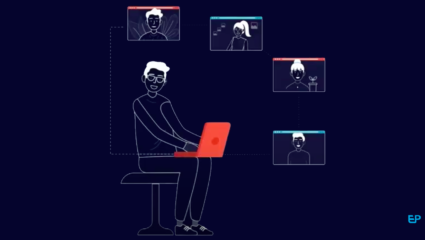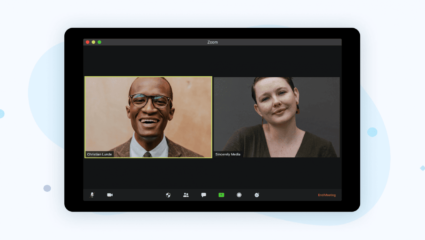No doubt by now you’ve run one, if not many virtual events. You’ve probably also attended a fair few yourself. So you have a sense of what works and what doesn’t from both an organiser’s and an attendee’s point of view.
We’ve helped produce loads of virtual events over the past 18 months – for all types of clients and all types of audiences. And we’ve noticed that there are ten important ingredients that make any virtual event successful.
So here we are, sharing that secret sauce with you now.

1. Group short sessions together with breaks in between
By far the best tip we can give any event organiser is to group your virtual sessions into manageable chunks.
No matter how brilliant your content or speakers are, attention spans are just not the same online.
We’ve found half-days work best to guarantee engagement but if you need to do a full-day virtual event, group a few shorter sessions into morning and afternoon blocks and make sure there is at least a ten minute break between each individual session.
Not only does this benefit your attendees but also gives some breathing space to your speakers, your tech team and your event team.
Further, communicate this structure to your attendees so they know when the breaks are (via the agenda and MC announcement). That way, they’ll be more focused during the sessions.
2. Always have moving content on screen before a session starts
Before a session starts, whether it’s the first session of the day or the first session after a break, we recommend you display some content.
At a minimum, show a holding slide and play some music. At best, show a blurred out live view of the studio with a countdown to when the session starts.
You could also take the opportunity to showcase sponsor content such as a video. Either way, the intent is to let your attendees know that everything is working correctly and how long they have to wait. With a blank screen, we’ve found they often feel concerned there’s a tech issue.

3. If you can’t have a live MC, have a pre-recorded one
We’ve seen some terrific MCs make a smooth transition across from live events to virtual. It’s a difficult skill to engage with an audience through a camera lens with hardly anyone in the room to vibe off, so we take our hats off to those talented speakers who do it well.
If you’re not able to have an MC live-streamed from a studio due to restrictions or availability, then we recommend you still engage an MC and pre-record a series of opening and closing videos.
Our partner platforms for example offer a video host feature which involves a video feed that plays over any sessions or areas of the platform. In it, hosts talk about what’s coming up and when, announce competitions, point out handy features on the platform and more. It’s almost like a voiceover at a live event. This helps to engage the audience a lot more than having them navigate through sessions on their own.
4. Incorporate ‘Disrupt Sessions’
If you have a lot of content and long sessions to get through during your virtual event, mix it up by incorporating ‘Disrupt Sessions’. A short, punchy 15 minute session that’s completely different to the rest of your content. It could be an interesting TED Talk, a performance, some fun entertainment, a workout session, a comedy skit – something to break up the content and invigorate your audience.
5. Don’t underestimate feedback surveys
We’ve noticed that feedback surveys have been under-utilised in virtual events of late. Our platforms allow for immediate feedback with short surveys able to be added onto the end of sessions.
Feedback is so important and in particular right now when there is so much still to learn when it comes to figuring out what works and what doesn’t for your specific virtual audiences.
If you’re utilising the platform’s gamification features, you can also reward your audience with points for completing feedback forms.
Further, these feedback surveys can help you to shape your next event and engage with your audience in between events. You can ascertain topics of interest and create campaigns around popular content to continue connecting with them.
6. Have someone dedicated to interacting with your audience online
One key aspect of live events that is difficult to replicate in a virtual environment is creating social connections and networking opportunities.
But we’ve seen some event organisers achieve positive outcomes with well-thought-out plans and a dedicated person to execute and manage it during the event.
Using a combination of platform features and external social media, you can curate a social journey for your attendees that could involve things like interactive selfie competitions, virtual backgrounds, themed photos or dress ups and then utilising hashtags and platform chat streams and gamification features – the result is a wealth of user-generated content and a highly engaged audience.
7. Everyone loves a free lunch
Just because your audience isn’t all in the same room doesn’t mean you shouldn’t all enjoy lunch together. We’ve seen virtual event organisers find success with shouting their audience to lunch via UberEats vouchers, or going one better and sending out personalised gift packs.
Just like live events, personalised touches always go down well.

8. Take it offline
We love seeing online events include offline sessions. With Zoom fatigue a real issue these days, organisers who include optional ‘movement sessions’ that encourage attendees to get out of their chairs, move their bodies and switch off in the breaks are always appreciated.
Whether it’s a walk & talk session, a fitness session led by an instructor or a morning yoga class – attendees will love you for it and you’ll find they are more engaged during the harder-hitting content.
9. Involve your exhibitors and sponsors early to optimise their ROI
Providing your exhibitors and sponsors with a handy guide on how to use your chosen platform will lead to greater return on investment for them, for you and for your attendees.
With the right platform, a clever set up and an informative exhibitor guide, you can ensure your exhibitors get matched to the most relevant attendees. Once they’re matched, you’ll want your exhibitors to be ready and able to use all of the platform features effectively to make the most of the opportunity.
So get them involved early, prepare them with guides, tips and training materials and watch the magic happen.
10. Make sure your speakers are well equipped
We’ll finish with a really important ingredient to successful virtual events. Make sure your speakers have the right tech equipment.
If you’re unable to use a professional studio, consider sending out a proper webcam, microphone and internet dongle to your speakers. Make sure they’re positioned in a well-lit space with minimal background noise. Ask them to test and rehearse with their equipment before their session as well as spend time exploring and using the platform itself to get familiar with it and ensure all settings are correct (that goes for exhibitors and sponsors too).
Quality content can be completely ruined when your speakers don’t use quality equipment and software. Ensure consistency across all of your speakers and their presentations by controlling what you can given the circumstances.

